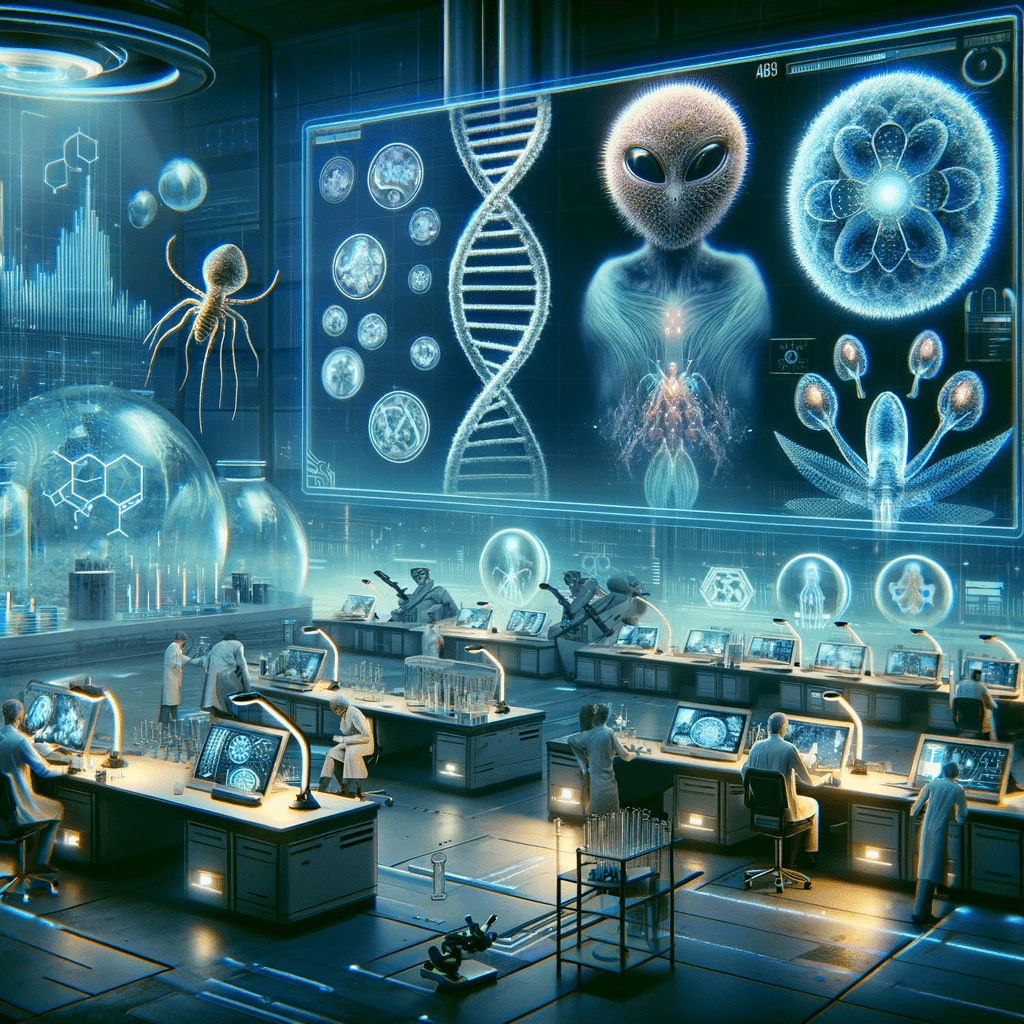Existence of ‘Non-Human’ Biologics

Non-Human biologics, the biological materials derived from alien organisms, have the potential to revolutionize our understanding of life and biology as we know it. The recovery and study of these non-human biologics provide unprecedented opportunities to explore the diverse structures and mechanisms that underpin life beyond Earth. These alien biologics, encompassing potential analogs of proteins, tissues, cellular systems, and more, offer a new frontier for scientific discovery and application. As we look into these categories through alien autopsies and experiments, we stand on the threshold of expanding our knowledge and potentially revolutionizing several scientific fields.
In a scientific context, “biologics” generally refers to products derived from living organisms. These can include a range of substances such as proteins, antibodies, nucleic acids, cells, and tissues. Biologics are typically utilized for their therapeutic, diagnostic, or preventive effects in medicine.
In the context of extraterrestrial life, the term “biologics” could be used to refer to biological substances or structures derived from alien organisms. While the term is usually associated with medical treatments, in this broader sense it could encompass any biological material with potential practical applications.
Some of the reasons “biologics” might be used to describe recovered alien life include:
- Biological Diversity: Alien life forms could potentially possess a range of biological structures or substances not found in Earth’s life forms. These “alien biologics” could have potential applications in a variety of fields, including medicine, materials science, and energy production.
- Understanding Life: By studying these “alien biologics”, scientists could gain insights into the fundamental nature of life itself, including its origins, evolution, and possible forms in the universe.
- Pharmaceutical Potential: If the extraterrestrial life forms were found to produce unique biological substances, these could potentially be studied and developed into novel therapeutic drugs. These could include proteins, peptides, or other biologically active molecules.
- Technological Applications: The unique properties of alien biologics could inspire or be directly applied to new technologies.
The term “biologics” is a shortened form of “biological products”.
Biologics include a variety of products, such as:
- Proteins: These include monoclonal antibodies and fusion proteins that are often used to treat diseases like cancer and autoimmune disorders.
- Vaccines: Vaccines are a classic example of biologics that are used to prevent a wide range of diseases.
- Blood and Blood Components: These can include whole blood, as well as specific components such as red or white blood cells, platelets, plasma, and clotting factors.
- Cell and Gene Therapies: These therapies aim to treat disease by altering, replacing, or supplementing a patient’s own cells or genes.
- Tissues: Transplanted tissues, such as skin grafts or corneal transplants, are also considered biologics.
- Recombinant Therapeutic Proteins and Peptides: These are proteins or peptides that are produced by genetically modified organisms. Insulin is a classic example.
Biologics are typically large, complex molecules produced using biotechnological processes. They may be composed of proteins, nucleic acids, carbohydrates, or a combination of these biological substances. Due to their complexity, they often require specialized manufacturing techniques and facilities.
Non-human biologics, in the context of extraterrestrial or interdimensional life, would refer to the study and utilization of biological substances, structures, or processes that are derived from alien organisms. The term “biologics” typically refers to products that are produced from living organisms or contain components of living organisms, such as antibodies, recombinant proteins, vaccines, and gene therapies.
In the context of aliens or extraterrestrial life, the specifics would depend largely on the biology of the discovered organisms, but some general aspects could be:
- Study of Alien Biology: Similar to the study of terrestrial life forms, the biology of extraterrestrial organisms could be studied for a better understanding of life itself. This would include understanding their genetic material (if any), their physiological functions, the way they reproduce, their metabolic pathways, etc.
- Therapeutics: If the extraterrestrial life forms were found to produce unique biological substances, these could potentially be studied and developed into novel therapeutic drugs. These could include proteins, peptides, or other biologically active molecules. The potential for new medicines could be enormous.
- Bio-Materials: Alien organisms might produce materials with unique properties that could be useful in various fields like construction, electronics, or manufacturing. For instance, spider silk is being studied on Earth for its incredible strength-to-weight ratio. Similarly, alien organisms might produce materials with properties that are not found on Earth.
- Energy Production: If the alien organisms have unique metabolic pathways, it might be possible to harness these for energy production. For instance, certain microorganisms on Earth are being studied for their ability to produce electricity.
The examination and exploration of extraterrestrial biologics can open up new horizons for understanding life itself. Whether it’s analyzing proteins that might be analogous to our antibodies, exploring alien cellular structures, investigating unique extraterrestrial tissues, or studying any form of recombinant therapeutic alien peptides, the potential insights are vast. Each discovery could redefine our approach to not only exobiology but potentially to medicine, materials science, and energy production. As our investigations into alien biology advance, we are entering an uncharted territory of biological discovery, promising unparalleled scientific breakthroughs and insights into life’s existence beyond our planet.


